U-BOATS SET TO TARGET U.S. EAST COAST SHIPPING
Berlin, Germany • December 13, 1941
On this date in 1941, just 2 days after Germany and the U.S. had declared war on each other, U‑boat Adm. Karl Doenitz initiated the Kriegsmarine’s wolf pack campaign against ill-prepared merchant shipping along the Canadian and U.S. eastern and Gulf seaboards. (Wolf packs consisted of a group of U‑boats systematically attacking Allied shipping.) In the eastern Atlantic, things had gotten dicey for Doenitz’s wolf packs. In mid-December heavily armed Grumman Martlets from the British escort carrier Audacity succeeded in keeping a dozen U‑boats and German aircraft away from a 32‑ship convoy that had left Gibraltar, at the western entrance of the Mediterranean Sea, for the British Isles, only to have their carrier sunk from under them by 3 torpedoes on December 21. The weeklong drama prompted Doenitz to record in his war diary: “The risk of being sunk is greater than the possible success. The presence of aircraft make[s] ‘wolf pack’ tactics impossible.”
So it was that Doenitz assigned 12 out of 91 operational U‑boats to American waters, where picking off merchantmen became child’s play. On January 11, 1942, Operation Paukenschlag (Operation Drumbeat, known informally among German submariners as the “American shooting season”) kicked off, and 5 German submarines began patrolling the east coast of North America. Among the first targets to be torpedoed were the 9,076‑ton British freighter Cyclops and the 9,577‑ton Norwegian petroleum tanker Norness bound for Halifax, port and capital of the Canadian province of Nova Scotia.
Although U-boats were not well suited to operations so far from home, they scored success after success in their new play area. Within the next month, the Drumbeat group sank over 26 Allied ships as they terrorized coastal shipping lanes. In just a single night’s booty off the North Carolina coast, U‑123 bagged 4 ships, among them the 5,269‑ton City of Atlanta, the 3,779‑ton Ciltvaira, and the empty tanker Malay, sending 46 merchant seamen to their deaths. Owing to the astonishing negligence by top U.S. Navy brass—especially by the irascible 63‑year-old Fleet Adm. Ernest J. King, Chief of Naval Operations, who snubbed the British Admiralty’s seasoned advice to establish East Coast escorted convoys—as well as the U.S. Navy’s monthslong recuperation from the near-fatal blow the Japanese had delivered to the Pacific Fleet at Pearl Harbor on December 7, 1941, it wasn’t until May of 1942 and President Franklin D. Roosevelt’s personal intervention that coastal convoys, destroyer escorts, and PBY Catalina flying boats were introduced on the East and Caribbean coasts, along with coastal blackouts and a U‑boat tracking center. In the 6 months the wolf packs were allowed to rampage along the North American coast, 432 ships and more than 2 million gross tons were lost together with nearly 5,000 men and women at a cost of only 8 U‑boats.
Battle of the Atlantic: Protecting the Transatlantic Pipeline Between the Americas and Europe
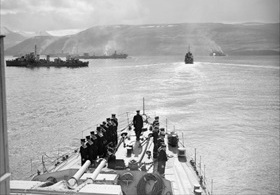 | 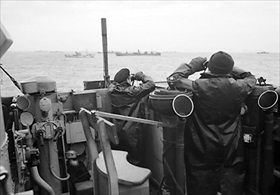 |
Left: Escorts and merchant ships in late June 1942 at the British naval base at Hvalfjord (Hvalfjörður), Iceland, 25 miles/40 km from Reykjavik, the island’s capital. During World War II nearly one-third of the world’s merchant shipping was British. Out of 36,000 merchant seamen who lost their lives between 1939 and 1945, over 30,000 were from the British Merchant Navy. More than 2,400 British ships were sunk out of the total of 2,900 Allied ships lost, or a loss of 14.6 million gross tons. A little over 9,500 U.S. merchant marines died at sea, in Axis POW camps, or of their wounds out of the roughly 243,000 who served. (The U.S. government never kept accurate records for its merchant marine.) Most of the ships sunk during the Battle of the Atlantic were not in convoys, but sailing alone, or had become separated from convoys.
![]()
Right: Officers on the bridge of an escorting British destroyer keep a sharp look out for enemy submarines, October 1941.
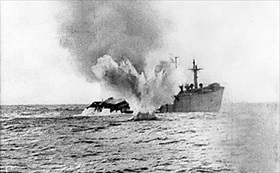 | 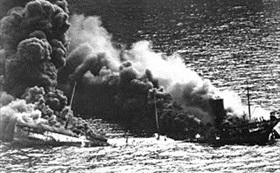 |
Left: An unnamed U-boat shells a merchant ship that had remained afloat after being torpedoed (no date). The focus on U‑boat successes—the “aces” and their scores, the number of convoys attacked, and the ships sunk—obscures the fact that during the Battle of the Atlantic only 10 percent of transatlantic convoys were ever attacked, and of those attacked only 1 in 10 ships on average was lost. Overall, more than 99 percent of all ships sailing to and from Great Britain during World War II did so safely. That said, however, the Battle of the Atlantic was the longest continuous and deadliest naval conflict in history.
![]()
Right: The 8,046-ton U.S. tanker Dixie Arrow was torpedoed by U‑71 on March 26, 1942, off Cape Hatteras, North Carolina. The ship is shown crumbling amidships under the heat of fire. Between June 1, 1941, and May 31, 1943, U‑71 with a crew of 29 carried out 10 war patrols. Operating out of the huge U‑boat pens at St. Nazaire in occupied France, U‑71 on her fifth foray sank 38,894 tons of shipping between March and April 1942. She was scuttled on May 2, 1945, in Wilhelmshaven, Germany, several days before the country’s surrender.
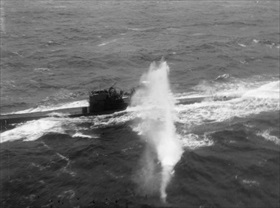 | 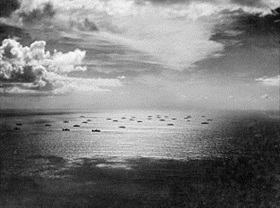 |
Left: A Grumman TBF Avenger from the Royal Navy’s Fleet Air Arm fires its machine gun at the conning tower of U‑288 during a convoy run to the Soviet Union, April 3, 1944. The U‑boat was eventually finished off by rockets and depth charges. Forty-nine men died; there were no survivors. The Kriegsmarine lost a total of 783 submarines and 30,000 sailors during the war. Despite their best efforts German submariners failed to stop the flow of strategic supplies to Great Britain. Between existing Allied merchant ships, U.S.-built Liberty ships (war-cargo vessels totaling 38.5 million tons), and British-built Empire ships, the Allies launched millions more ship tonnage than the 14 million tons of shipping lost to the U‑boat menace.
![]()
Right: At the height of the Atlantic campaign, U‑boats failed to hinder or even detect the U.S. invasion fleet headed to North Africa in November 1942 (Operation Torch), and they failed to prevent the build-up of troops and supplies needed for the D-Day landings in June 1944. As early as May 1943, when a fifth of his U‑boats were sunk in “Black May,” Grand Admiral Doenitz conceded that Germany had lost the Battle of the Atlantic.
German U-Boats and the Battle of the Atlantic
![]()

 History buffs, there is good news! The Daily Chronicles of World War II is now available as an ebook for $4.99 on Amazon.com. Containing a year’s worth of dated entries from this website, the ebook brings the story of this tumultuous era to life in a compelling, authoritative, and succinct manner. Featuring inventive navigation aids, the ebook enables readers to instantly move forward or backward by month and date to different dated entries. Simple and elegant! Click
History buffs, there is good news! The Daily Chronicles of World War II is now available as an ebook for $4.99 on Amazon.com. Containing a year’s worth of dated entries from this website, the ebook brings the story of this tumultuous era to life in a compelling, authoritative, and succinct manner. Featuring inventive navigation aids, the ebook enables readers to instantly move forward or backward by month and date to different dated entries. Simple and elegant! Click 











